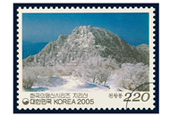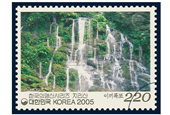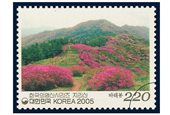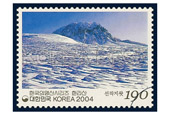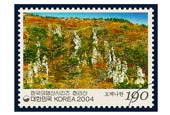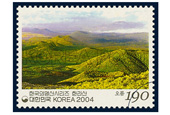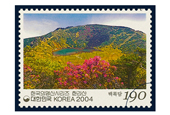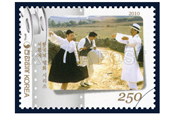-
 Korea.net's 24-hour YouTube channel
Korea.net's 24-hour YouTube channel- NEWS FOCUS
- ABOUT KOREA
- EVENTS
- RESOURCES
- GOVERNMENT
- ABOUT US
Seoraksan Mountain (설악산, 雪嶽山) covers almost 400 square kilometers and is the third highest mountain in South Korea, behind Hallasan and Jirisan. The mountain's lower reaches stretch as far as Sokcho City and Yangyang-gun, Goseong-gun and Inje-gun counties. As seen in its name, snow falls on the mountain first and remains there longest throughout the season among mountains in South Korea.
There are numerous rare animal and plant species that call the mountain home, as well some that are in danger of extinction. The mountain has been officially designated as a natural protected area and it has been safeguarded as a Biosphere Reserve by UNESCO since 1982.
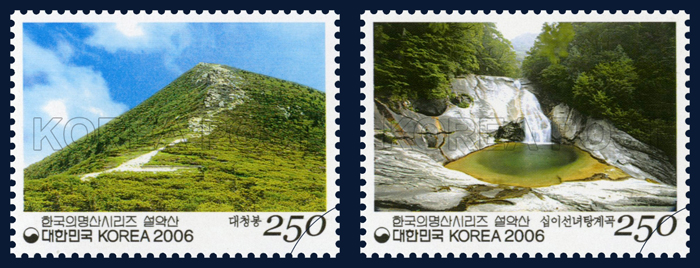
Daecheongbong Peak, the highest point atop Seoraksan Mountain, stands 1,708 meters above sea level. It is the starting point for major ridgelines and is a junction between the inner and outer parts of the mountain. Most of the valleys, including Cheonbuldong and Gayadong, start there.
Due to unstable weather conditions, strong winds and low temperatures, only colonies of creeping pine can cover the peak. Because the trees grow so low to the ground, as if they were carpeting, hikers can have a clear view of the entire national park from the peak, and even of the East Sea. The view of the sunrise from the peak is spectacular. The peak is covered with azaleas and cherry blossoms in June and July.
Sibiseonnyeotang Valley, one of the major attractions at the mountain, connects Daeseungnyeong Pass and the Jangsudae cabin. Clear streams stretch a long distance, as if transparent beads are strung after one another.
Seonnyeotang is literally a bath for fairies or heavenly maidens, and the valley was named thus due to a myth that fairies came down from the sky and bathed there at night. Though sibi means, "twelve," there are only eight natural basins in the valley. A stream of transparent water flows over the moss-covered valley and is tinted the color of jade, creating a magnificent view.

By Limb Jae-un
Korea.net Staff Writer
Photos courtesy of Korea Post
jun2@korea.kr
There are numerous rare animal and plant species that call the mountain home, as well some that are in danger of extinction. The mountain has been officially designated as a natural protected area and it has been safeguarded as a Biosphere Reserve by UNESCO since 1982.

Korea Post's 2006 stamps show Daecheongbong Peak (left) and Sibiseonnyeotang Valley.
Daecheongbong Peak, the highest point atop Seoraksan Mountain, stands 1,708 meters above sea level. It is the starting point for major ridgelines and is a junction between the inner and outer parts of the mountain. Most of the valleys, including Cheonbuldong and Gayadong, start there.
Due to unstable weather conditions, strong winds and low temperatures, only colonies of creeping pine can cover the peak. Because the trees grow so low to the ground, as if they were carpeting, hikers can have a clear view of the entire national park from the peak, and even of the East Sea. The view of the sunrise from the peak is spectacular. The peak is covered with azaleas and cherry blossoms in June and July.
Sibiseonnyeotang Valley, one of the major attractions at the mountain, connects Daeseungnyeong Pass and the Jangsudae cabin. Clear streams stretch a long distance, as if transparent beads are strung after one another.
Seonnyeotang is literally a bath for fairies or heavenly maidens, and the valley was named thus due to a myth that fairies came down from the sky and bathed there at night. Though sibi means, "twelve," there are only eight natural basins in the valley. A stream of transparent water flows over the moss-covered valley and is tinted the color of jade, creating a magnificent view.

The third stamp set in the 'Celebrated Mountains of Korea' series shows many of Seoraksan Mountain's scenic spots.
By Limb Jae-un
Korea.net Staff Writer
Photos courtesy of Korea Post
jun2@korea.kr
Related Contents
Most popular
- First hearing-impaired K-pop act hopes for 'barrier-free world'
- Event 'K-Beauty Hang Out' draws hundreds in Philippines
- Ceremony in Seoul inducts 2,641 content creators of Korean culture
- 'Mad Max' director impressed by 'cinema-literate' Korean viewers
- Romanian presidential couple visits national cemetery









